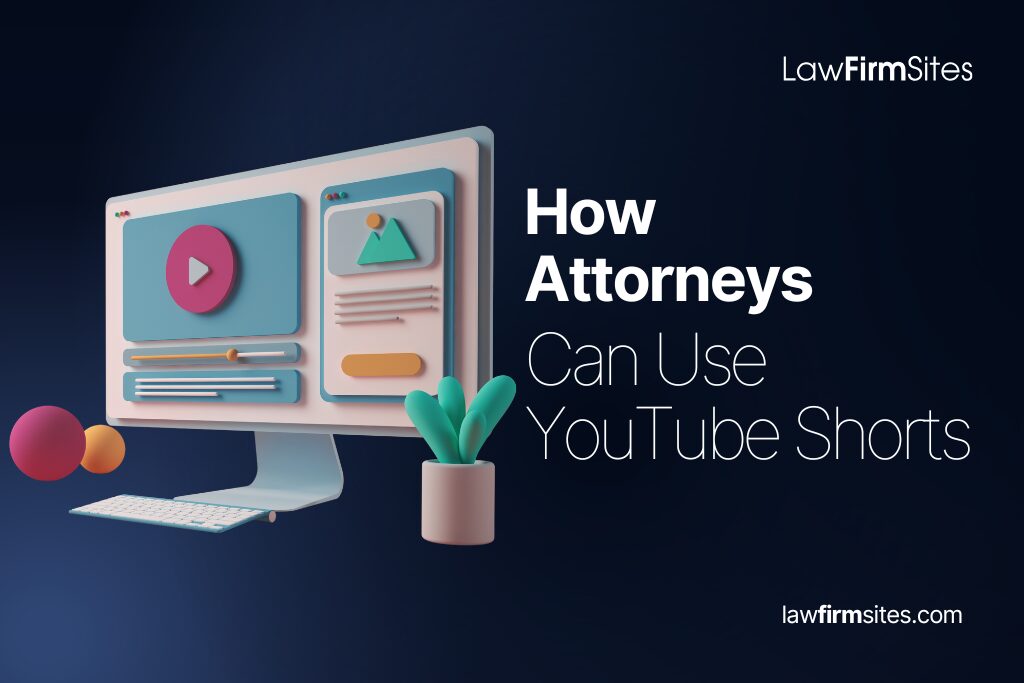How Attorneys Can Use YouTube Shorts?

YouTube Shorts is one of the fastest ways for lawyers to meet today’s attention economy, where it lives – on mobile devices. Short videos lower the barrier between a prospective client’s question and your answer, making legal information more approachable and memorable. When planned with care, Shorts can drive brand awareness, organic visibility, and qualified inquiries without the production overhead of long videos. This guide explains what YouTube Shorts are, why they matter for attorneys, and how to make them work for your firm.
What Are YouTube Shorts?
YouTube Shorts are vertical, short-form videos that appear in a dedicated feed inside YouTube’s mobile and desktop experiences. They load quickly, loop automatically, and surface to viewers based on their interests and watch history, which gives creators the ability to be discovered by new audiences well beyond their subscriber base. Originally capped at 60 seconds, Shorts now allow up to three minutes, offering lawyers more room to answer a question or demonstrate a step‑by‑step process while still keeping the experience snappy. The creation tools inside the YouTube app also include on‑screen text, captions, a multi‑clip editor, a robust audio library, and remix features that let you pull a clip from your own long‑form videos to turn into a Short.
From a channel perspective, Shorts sit alongside your long videos, live streams, and Community posts. That “multi‑format” presence helps potential clients discover you via a Short and then move seamlessly to your playlists, evergreen explainers, and practice‑area pages linked from your channel. Because Shorts are native to YouTube, they inherit the platform’s searchability, recommendations, and analytics, allowing law firms to track watch time, audience retention, and growth without adding another social network to manage.
Why Lawyers Should Utilize YouTube Shorts?
Short, vertical videos meet clients where they already search for quick answers and plain‑language explanations. That said, publishing consistent YouTube Shorts turns common questions into approachable guidance, expands organic reach on YouTube, and invites viewers to explore your deeper resources when they’re ready. Here are some reasons why they should be utilized:
Extend your audience and client reach
Shorts operate inside the world’s most‑used video platform. They surface to people who aren’t yet searching for your name but are curious about a legal topic, such as “security deposit disputes,” “DUI first offense,” “green card interview tips,” “estate tax thresholds,” and more. When your Short delivers a useful answer in under a minute, the viewer gets immediate value, and the algorithm gets a strong signal to show your content to similar viewers. That exposure compounds, sending new traffic to your channel, website, and intake forms. For solo and boutique practices, Shorts can punch above their weight by delivering consistent reach without heavy ad spend.
Adapt to generational changes
Younger audiences increasingly prefer short‑form video for quick research and decision‑making. YouTube’s dominance across age groups means Shorts can meet both Gen Z and older demographics where they are. For a family law or immigration practice, that cross‑generational reach is crucial – the adult child researching for a parent, the employer looking up compliance, or a spouse trying to understand timelines. Publishing a steady cadence of Shorts keeps your brand visible during those micro‑moments when people seek fast, credible answers.
Quick and seamless showcase of knowledge
Shorts allow you to compress a focused legal insight into a digestible story. A probate lawyer can explain “letters testamentary” in 45 seconds. A criminal defense attorney can break down implied consent or the difference between an arraignment and a preliminary hearing. An employment lawyer can cover the essentials of non‑compete enforceability in a specific state. This format builds recognition through repetition: viewers learn to trust your clear, on‑camera explanations, your on‑screen disclaimers, and your consistent visual style. Over time, your channel becomes a library of bite-sized guidance that demonstrates steady, reliable judgment.
Encourage engagement
Shorts spark comments, saves, and shares precisely because they are easy to watch to completion. A complete view paired with a quick comment, such as “Does this apply in New Jersey?” signals quality and can broaden distribution. You can nurture that conversation by replying in the comments and by publishing a follow‑up Short using the same title pattern to answer the next natural question. Engagement compounds when you invite viewers to watch a longer video or download a checklist that expands on the YouTube Shorts’ topic. Even without clickable links in the YouTube Shorts’ description, pinned comments, on‑screen prompts, and your channel’s About tab can guide viewers to the next step.
The Sweet 15: Tips to Craft Compelling Shorts
In today’s fast-paced digital age, clarity wins in under a minute – that’s why it is important to open with the question, deliver the takeaway, and support it with one practical detail. These are some tips that can aid in creating your law firm’s most engaging YouTube Shorts:
- Start with a hook that promises clarity
Open with the exact question your client would ask in plain language. Instead of “Recent statutory updates in landlord‑tenant law,” say “Can a landlord keep your security deposit for cleaning?” State the answer early, then add the nuance. This structure respects viewer time and earns completion, which helps distribution.
- Write for one outcome
Each Short should deliver a single takeaway: a definition, a checklist, a myth‑buster, or a next step. If you try to cover multiple issues, the message blurs and retention drops. Keep it to one concept per clip and link related videos in your description or playlists so viewers can continue down a focused path.
- Use on‑screen text and captions for silent viewing
Many people watch without sound. Place a concise headline at the top third of the frame and time your captions to each phrase, not whole sentences. If English is a second language for your audience, concise captions help comprehension and reduce drop‑offs.
- Frame for vertical and protect the “safe zones”
Record in 9:16 and leave space for UI elements along the right edge and bottom. Keep your face or demo subject in the center third. If you add graphics, avoid the areas where the like, comment, and share buttons appear so nothing essential is obscured.
- Script tight but make it natural
Write a 3–5 line outline instead of a full teleprompter script. Speak as you would to a client in a consultation, with concrete verbs and plain words. If you need a pro tip, record two takes: one at normal pace and one slightly faster, then choose the take that feels brisk but clear.
- Explain the “why” in simple terms
People watch YouTube Shorts when they want fast help. After you state the answer, add a quick rationale: “Here’s why a restaurant slip‑and‑fall is different from a private home,” or “This is why an unsigned will can still be valid in our state.” These quick explanations set you apart from generic content.
- Design repeatable formats
Build a series with consistent titles and thumbnails for pattern recognition. Examples include “60‑Second Statutes,” “Myth vs. Law,” “Courtroom Terms Defined,” or “Forms 101.” When you reuse the same opener and visual structure, production gets easier, and your audience knows what to expect.
- Remix your long‑form videos into YouTube Shorts
If you already have webinars, CLEs, or walkthroughs, cut them into 30–60 second clips focused on one insight each. Add a text overlay with the long video’s title and a line like “Full breakdown on our channel” to guide viewers. This approach compounds the ROI of content you have already produced and creates a bridge between discovery and deeper education.
- Optimize titles and descriptions for search
Use a plain‑English title that includes a core legal phrase and the jurisdiction when relevant. Keep descriptions concise, add a short summary of the key point, and include related keywords naturally. Hashtags help discovery, but clarity in your title is more important than a long hashtag list.
- Clarify the scope and add a visible disclaimer
Place a brief on‑screen disclaimer at the start or end, such as “Informational only, not legal advice; consult counsel for your facts.” This sets expectations and reinforces that a Short is general education, not a substitute for formal counsel.
- Post on a cadence you can sustain
Consistency is more important than volume. A steady rhythm, such as three Shorts per week, helps build audience habit and provides enough data to refine your approach. Treat your first month as a learning sprint: test hooks, topics, and styles, then double down on what retains viewers.
- Measure retention, not just views
Aim for a clean curve with minimal early drop‑off. If your first two seconds lose half your audience, your hook needs work. Watch where viewers rewind or watch again; those are moments to recreate in future Shorts. Over time, a combination of higher retention and repeat viewing tells the system your content is helpful, which boosts distribution.
- Mind links and off‑platform calls to action
URLs in Shorts descriptions are not clickable, so move key calls to action to your channel’s About section, your banner links, and your long‑form video descriptions. Within the Short, prompt viewers to “See the full guide on our channel” or “Check our intake checklist linked on our profile.”
- Prioritize accessibility and trust signals
Add accurate captions, avoid jargon, and keep lighting and audio clean. Pin a comment that restates the key takeaway with a gentle next step, such as “Need more detail? Watch our full 5‑minute explainer on [topic] in our channel videos.” Professional presence matters as much as the tip itself.
- Respect advertising and promotion rules. If you host a giveaway, feature a sponsor, or use paid placements, follow platform rules and your jurisdiction’s ethics rules. Clear labeling and straightforward language build viewer trust and protect your practice.
Increase your Audience Reach with Short Clips
When approached as an educational service, YouTube Shorts can amplify a lawyer’s reach, strengthen brand recall, and guide viewers to deeper resources that answer their next question. The key is to respect the format – clear hooks, single outcomes, and strong captions, while maintaining accuracy and clarity that reflect your standards. If you’re ready to build a repeatable Shorts workflow tied to your editorial calendar and intake goals, explore templates and publishing checklists from trusted sources and adapt them to your practice.
For a streamlined setup, content planning, and on‑brand execution, Law Firm Sites can help you align your YouTube Shorts strategy with a modern legal website and SEO plan.
Did you like this post? Here are some others you might enjoy:

For most law firms, growth depends on being visible at the exact moment a potential client searches for help. Pay‑per‑click…

Strong legal marketing rewards depth. When potential clients face high-stakes decisions, they search for thorough, trustworthy guidance that clearly explains…

Data is the most reliable guide for growing a law firm website because it shows what clients actually search, where…

